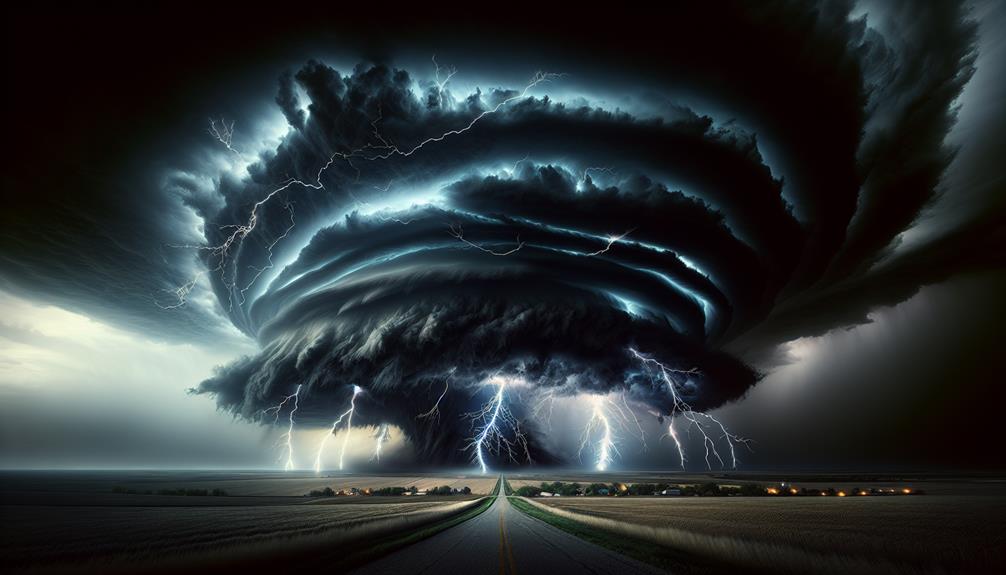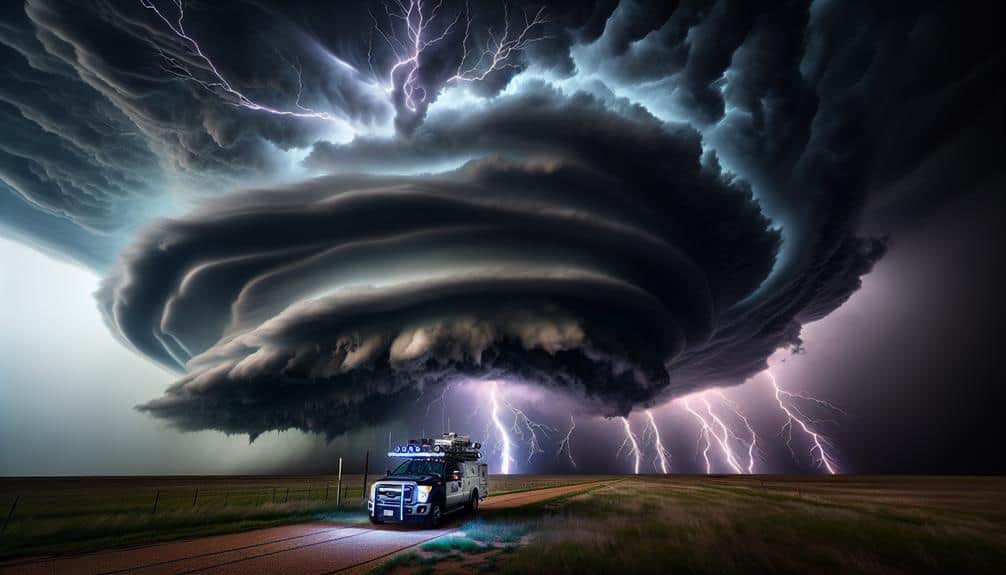We've identified seven supercell storms with unprecedented destruction: the 1974 Xenia Tornado (F5, 34 fatalities, 32-mile path), the 1999 Bridge Creek Tornado (EF5, >300 mph winds), the 2007 Greensburg Tornado (EF5 with 205 mph winds, 95% of town obliterated), the 2011 Joplin Tornado (158 deaths, >200 mph winds), the 2013 El Reno Tornado (record 2.6-mile width), the 2017 Canton Tornado (economic impact of $30 million), and the 2020 Nashville Tornado (25 deaths, $1.6 billion in damages). These events underscore the critical need for advanced storm preparedness and resilient infrastructure strategies. Discover the intricate details behind each storm's impact.
Key Points
- The 1974 Xenia Tornado was an F5 event that caused extensive damage and 34 fatalities over a 32-mile path.
- The 1999 Bridge Creek Tornado, an EF5 storm with 300 mph winds, set new standards for tornado-resistant construction.
- The 2007 Greensburg Tornado, an EF5 storm, obliterated 95% of Greensburg, Kansas, emphasizing sustainable rebuilding practices.
- The 2011 Joplin Tornado resulted in 158 fatalities, highlighting the importance of resilient infrastructure and community warning systems.
The 1974 Xenia Tornado
The 1974 Xenia Tornado, part of the larger 1974 Super Outbreak, was an F5-rated event that caused extensive damage and resulted in 34 fatalities. As we analyze this catastrophic event, we must focus on the impact on the Xenia community and the subsequent rebuilding efforts.
The tornado's path of destruction spanned 32 miles, obliterating homes, schools, and businesses, leaving approximately 1,150 structures severely damaged or completely destroyed. The local infrastructure faced a monumental challenge, demanding immediate and long-term recovery strategies.
Tornado warnings were issued approximately 30 minutes before the tornado struck, providing critical lead time for emergency response teams to mobilize. Volunteer groups, first responders, and federal agencies coordinated efforts to conduct search and rescue operations, provide medical care, and establish temporary shelters. Despite the devastation, the Xenia community demonstrated resilience, coming together to support one another through the aftermath.
Our collective efforts in rebuilding Xenia required meticulous planning and resource allocation. Federal disaster relief funds, coupled with community-driven initiatives, facilitated the reconstruction of essential services and residential areas. The emphasis on improved building codes and advanced warning systems aimed to mitigate future risks, ensuring the community's preparedness for subsequent tornado events.
The 1999 Bridge Creek Tornado
Occurring on May 3, 1999, the Bridge Creek Tornado was an EF5-rated storm that achieved wind speeds exceeding 300 mph, marking it as one of the most intense tornadoes ever recorded. This supercell manifested unprecedented structural damage, obliterating homes and infrastructure within its 38-mile path. Wind velocities measured by Doppler radar revealed gusts peaking at 318 mph, a record in meteorological data.
Our emergency response was swift; first responders mobilized immediately, prioritizing search and rescue operations. The community resilience demonstrated in the aftermath was extraordinary. Volunteers and local organizations coordinated to provide immediate relief, including temporary shelters and medical care. This rapid mobilization underscored the importance of preparedness in mitigating catastrophic impacts.
The structural damage was extensive, with entire neighborhoods reduced to debris fields. Recovery efforts required significant resources, including federal aid and insurance payouts, to rebuild. Engineers and urban planners focused on enhancing building codes to withstand future events. Lessons learned from Bridge Creek influenced national guidelines on tornado-resistant construction.
The 2007 Greensburg Tornado
On May 4, 2007, we witnessed the devastating force of an EF5 tornado that obliterated 95% of Greensburg, Kansas, with wind speeds reaching approximately 205 mph.
The supercell thunderstorm, characterized by its rotating updraft, exhibited a classic structure conducive to tornado genesis. The damage path stretched 1.7 miles wide, producing a swath of destruction that left the community in ruins.
In the aftermath, our focus shifted to reconstruction efforts and community resilience. Greensburg's population, demonstrating remarkable fortitude, embarked on rebuilding with sustainable practices in mind. Leveraging federal and state aid, the town adopted green technology and energy-efficient infrastructure, setting a precedent for disaster recovery. This resilience underscores the human spirit's capacity to rebuild stronger and smarter.
Climate change, with its potential to alter atmospheric dynamics, raises concerns about increasing tornado frequency and intensity. While direct causation remains under scientific scrutiny, the heightened variability in weather patterns warrants our attention.
As we analyze these trends, we're reminded of the critical importance of preparedness and adaptive strategies in mitigating future risks. The 2007 Greensburg Tornado serves as a stark reminder of nature's power and our responsibility to foster resilient communities amidst evolving climatic conditions.
The 2011 Joplin Tornado
Marking one of the deadliest tornadoes in U.S. history, the 2011 Joplin Tornado resulted in 158 fatalities and caused $2.8 billion in damages. This EF5 tornado exhibited exceptional tornado intensity with wind speeds exceeding 200 mph. It carved a path of destruction stretching approximately 22.1 miles, severely impacting residential areas, commercial structures, and critical infrastructure.
We observed that the emergency response was immediate and multifaceted. Local emergency services, state agencies, and federal resources mobilized rapidly to provide medical aid, search and rescue operations, and disaster relief. The event underscored the critical need for robust emergency management frameworks that can adapt to high-intensity tornado scenarios. The Federal Emergency Management Agency (FEMA) and the National Weather Service (NWS) played pivotal roles in coordinating efforts and disseminating information.
In analyzing the aftermath, we can see the importance of advanced meteorological forecasting and public preparedness. The tornado's intensity was a stark reminder of nature's unpredictability, emphasizing the need for resilient infrastructure and effective community warning systems. By understanding the dynamics of such extreme events, we can better prepare for future occurrences, ensuring that our responses are swift and life-saving.
The 2013 El Reno Tornado

Following the devastation of the Joplin Tornado, the 2013 El Reno Tornado presented another formidable challenge with its record-breaking width of 2.6 miles and wind speeds reaching 296 mph, making it the widest tornado ever recorded. This behemoth storm created an unprecedented scenario for tornado chasers, delivering both an adrenaline rush and significant risk. The storm's rapid intensification and erratic path led to severe consequences, including the tragic loss of veteran chaser Tim Samaras.
From a technical perspective, the El Reno Tornado underscored the essential need for advanced storm preparedness. Doppler radar data revealed complex multi-vortex structures, complicating real-time analysis and prediction. We must emphasize safety tips: always have a designated shelter, a battery-powered weather radio, and an emergency kit ready.
Moreover, the El Reno event highlighted the significance of understanding tornadogenesis and storm dynamics. Our collective knowledge advanced with the data collected, yet the sheer power of the storm reminded us of nature's unpredictability.
For those seeking freedom in the chase, it's vital to balance the adrenaline rush with stringent safety protocols. As we continue studying these phenomena, the lessons from El Reno remain crucial for future storm preparedness and research.
The 2017 Canton Tornado
Let's examine the 2017 Canton Tornado, focusing on its formation process, damage metrics, and aftermath.
We observed a rapidly evolving mesocyclone that initiated the EF-4 tornado, producing wind speeds exceeding 166 mph.
The tornado's impact resulted in over $40 million in damages and significant structural devastation, underscoring the storm's catastrophic nature.
Tornado Formation Process
Understanding the tornado formation process during the 2017 Canton Tornado requires a detailed examination of the mesocyclone's evolution, wind shear interactions, and thermal dynamics within the supercell.
Initially, the meteorological conditions featured a potent combination of high instability and significant wind shear. The supercell's updraft began to rotate, forming a mesocyclone due to the vertical wind shear. This rotation is pivotal for tornado formation, as it provides the necessary angular momentum.
As the mesocyclone evolved, low-level inflow intensified, with warm, moist air being drawn into the system. This influx of buoyant air enhanced the updraft's strength and allowed the mesocyclone to stretch vertically. The thermal dynamics within the supercell facilitated the condensation of water vapor, releasing latent heat and further energizing the updraft.
Concurrently, downdrafts on the storm's rear flank contributed to the development of a rear-flank downdraft (RFD), which played a critical role in concentrating the vorticity. The interaction between the RFD and the mesocyclone culminated, resulting in the formation of a low-level rotation funnel.
As this funnel extended to the ground, it intensified, becoming the destructive Canton Tornado. Our understanding of these processes underscores the complexity and power inherent in supercell storms.
Damage and Aftermath
The 2017 Canton Tornado caused extensive damage, obliterating over 150 structures and resulting in significant infrastructural and economic impacts. We observed widespread infrastructure damage, including the complete destruction of residential buildings, commercial establishments, and critical utility lines. Power outages affected thousands, disrupting daily life and local businesses. In the immediate aftermath, recovery efforts were swift but required coordinated action between local government, emergency services, and volunteer organizations.
Community resilience was evident as we commenced the rebuilding process. Citizens united to clear debris, repair homes, and restore essential services. The economic impact was substantial, with initial estimates placing damages at over $30 million. Federal and state aid played an important role in recovery, providing necessary funds for reconstruction and infrastructure rehabilitation.
Rebuilding efforts emphasized not just restoration but also future-proofing against similar disasters. We implemented enhanced building codes and invested in advanced weather monitoring systems. The community's proactive approach underscored our collective determination to not only recover but also strengthen our defenses against future supercell storms.
Through strategic planning and collaborative effort, Canton's recovery became a tribute to effective crisis management and the indomitable spirit of its residents.
The 2020 Nashville Tornado

Striking Nashville on March 3, 2020, the EF3 tornado carved a path of destruction spanning 60.13 miles, causing significant structural damage and resulting in 25 fatalities. The tornado impact was profound, as it damaged over 2,000 homes and businesses, leading to an estimated $1.6 billion in damages. Key infrastructures like the John C. Tune Airport sustained catastrophic damage, disrupting local and regional transportation. The twister's intensity, with wind speeds reaching 165 mph, obliterated entire neighborhoods, leaving scores homeless and critical services overwhelmed.
In response, the community mobilized rapidly, showcasing remarkable resilience and solidarity. Volunteers, local organizations, and emergency services coordinated efficiently to provide immediate assistance. Shelters were established, distributing essential supplies such as food, water, and medical aid. The Tennessee Emergency Management Agency (TEMA) activated its emergency operations center, facilitating resource allocation and communication. Meanwhile, utility crews worked tirelessly to restore power to the tens of thousands left in the dark.
We saw an outpouring of support from across the nation, with donations and aid flowing into the affected areas. The collective effort underscored our capacity for unity and determination in the face of natural disasters, reinforcing the spirit of freedom and community strength.
Frequently Asked Questions
What Is a Supercell Storm, and How Does It Form?
We should understand that a supercell storm forms from specific atmospheric conditions and weather patterns. Thunderstorm development involves rotating updrafts called mesocyclones, driven by significant wind shear and instability during storm formation.
How Can One Stay Safe During a Supercell Tornado?
In supercell tornadoes, 80% of fatalities occur from flying debris. We should prioritize emergency shelters and conduct regular drills. Implementing safety precautions and having clear evacuation plans guarantees our safety and preserves our freedom during these events.
What Are the Common Signs That a Supercell Storm Is Approaching?
We can identify an approaching supercell storm by observing specific indicators: unique cloud formations, frequent lightning strikes, abrupt temperature drops, and shifting wind patterns. Recognizing these signs early enables us to take necessary precautions and guarantee our safety.
How Do Meteorologists Predict and Track Supercell Storms?
How do meteorologists predict and track supercell storms? We use advanced weather technology, forecasting models, and collaborate with storm chasers. These tracking techniques help us analyze atmospheric data, ensuring we provide accurate, timely warnings for maximum safety and freedom.
What Impact Do Supercell Storms Have on Local Wildlife and Ecosystems?
Supercell storms devastate wildlife habitats, reducing biodiversity. Climate change exacerbates this, weakening ecosystem resilience. Data shows significant declines in species populations post-storms, indicating the urgent need for adaptive strategies to mitigate these impacts and preserve ecological freedom.


